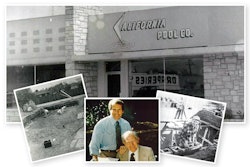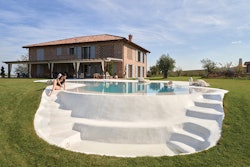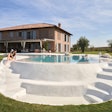
When things are exactly what they seem, it's easy to categorize them. Take filter media. Sand is time-tested and costeffective, cartridges are easy to set up and clean without backwashing, and diatomaceous earth (D.E.) gives the greatest water clarity.
Introduce alternative media, filter aids, and new approaches to designing the filters, and those distinctions become less clear.
Today's attempts to enhance pool filtration have one thing in common: They intend to improve water quality while also simplifying maintenance. For example, many claim to offer D.E. clarity with the convenience of sand or cartridge filtration.
The varied approaches to improving filtration can be divided into four areas: materials that replace traditional media; materials added to traditional filters to help them filter finer particles; products poured into the water to aid filtration; and, lastly, design enhancements to the filters themselves.
Changing Faces
Cellulose fiber is perhaps the most frequently used alternative. Its primary use in pool filtration is as a replacement for diatomaceous earth. Unlike D.E., cellulose fiber is consumable and biodegradable.
"We market cellulose fiber as a tremendous replacement for D.E. because it filters finer, is biodegradable, is non-toxic and more convenient," says Gene Fields, president of SWIM, which sells the Fiber Clear brand. Similar claims are made by Jack's Magic about PureFiber.
Cellulose fiber differs from D.E. in several important ways. For one thing, it is a renewable resource, F ields explains. "It's wood pulp ground to a specific consistency to be effective in a D.E. filter," he says. Similar technology has been used in the food processing, beer brewing and winemaking industries. It is also used in breads, cereals and pharmaceuticals.
Kevin Potucek, vice president of marketing at Hayward Pool Products, also recognizes the benefits of cellulose fiber. Cellulose fiber is attractive for pool owners who want the clarity associated with D.E. filtration, but who live in an area where local regulations prevent its use, he says.
Steve Gutai, product manager for pumps, filters, valves and water features at Jandy, also embraces the potential of D.E. alternatives that can overcome environmental constraints, but he cautions that some building and safety inspectors may not approve installations if they don't understand that something other than D.E. is inside a filter.
Perlite is another replacement for D.E. Like cellulose fiber, perlite has been used in the brewing and pharmaceutical industries to provide fine polish filtration. Also, both perlite and cellulose fiber weigh less than D.E., are environmentally friendly and can filter particles in the same minute size range as D.E. (around 5 microns). Perlite is a mined, volcanicrock material that has been used in pool filters for decades.
D.E. isn't the only media being replaced in traditional filters. Filbur Manufacturing, a leading supplier of the material used to make filter cartridges, has developed a media that gives D.E.-type clarity with the ease and convenience of cartridge filtration, according to Kevin Miller, vice president of sales and marketing. On the market for less than a year, Filbur's Sureflo is a multi-layer synthetic material that borrows depth-filtration technology from the drinking water industry. Sureflo uses its depth, rather than the total square footage, Miller explains. The new media fits into existing cartridge filter systems and allows for increased flow rates.
Although the first backwash of a zeolite bed takes longer than a standard sand backwash, time between backwashes is longer. The filter cycle will vary according to the size of the filter, bather load, and all the usual factors (system efficiency, water chemistry, etc.), but some say it can be as long as six months. Sand filters typically must be backwashed every few weeks, depending on bather load. Proponents of zeolite as a replacement for sand point out that longer filter cycles save water, chemicals, energy and labor.
The rising acceptance of zeolite as an alternative for sand filters explains why chemical suppliers have developed products for recharging zeolite media beds. Clean & Refresh, from Ultima, is one such product. It is also possible to recharge a zeolite media bed by adding a mild sodium chloride solution to the filter bed.
Both cellulose fiber and zeolites work in most existing filter tanks, but Mark Normyle, Hayward's product manager for filters, says turbidity test results have shown that it takes longer to clear water with cellulose fiber or zeolites than with plain D.E. or sand.
Helping Hands
Some of these materials are also being used in tandem with, rather than as a replacement for, traditional media. For example, cellulose fiber can be used as a prefilter in a cartridge filter. "Cellulose fiber will take a 10- to 20micron cartridge filter down to 2 microns," says Fields. When you add cellulose fiber to a cartridge, he explains, the cartridge becomes a septum, rather than the primary filter media. Fields argues that using cellulose fiber as a prefilter saves the cartridge itself. "When it's loaded up, you hose the [ fiber] off, wash away impurities along with it, and you have a new cartridge again."
D.E. has also been used for that purpose, but filter manufacturers warn that it gets embedded in the creases of a typical pleated cartridge. Using D.E. in a cartridge filter also shortens the time between cleanings.
Hayward's Potucek cautions that combining media may give some added benefits, "but you detract from some of the advantages that each media had on its own," he says. "One advantage of cartridge filtration is you simply take it out when it's time to clean it. There's no added media, you just clean off the debris. Cartridge filtration gives you simple clean-up and long filter cycles. Once you coat your media, you shorten the cycle and take away the advantage of quick clean-up."
Also, Potucek continues, "The marvel of D.E. is that it regenerates. Every time it drops off the grids and goes back up and recoats the grid, you get a different side of those complex particles ready to catch more dirt." If you use D.E. in a standard cartridge filter, there's no recoating mechanism, so the D.E. is used once and must be disposed of.
Another use of alternative media as a filter aid is adding cellulose fiber to a sand filter to clear water quickly. This temporary measure loads the sand bed with fiber; together, the sand and fiber can filter down to 2 microns. The filter will load up quickly, however, so this procedure also requires backwashing within 24 hours. Heavily used commercial pools may do this monthly.
Pouring clarifiers and flocculants into pools or filters is another way to aid filtration. There are many good clarifiers and floccing agents available. They cause particles to bond chemically, forming larger particles that filters are able to catch. It can even be said that some filter aids give sand the ability to filter like D.E.
Flocculants are most beneficial for sand filters because on their own, typical sand filters will pick up particles down to 50 microns, explains Terry Arko, a spokesman for SeaKlear. However, many contaminants of a submicron size can get by even D.E., so complete flocculation can help here as well, Arko adds. The parasite Cryptosporidium, which measures 4 to 6 microns, actually has the ability to compress and squeeze itself through smaller filter media such as D.E. This is where SeaKlear's PRS two-stage floccing system, which recently received EPA approval for its ability to trap Crypto, can assist all filtration systems to ensure good quality water.
Nextgen Filters
In addition to developments in media and filtration aids, one filter manufacturer has recently introduced two variations on filter technology, both of which claim to offer the benefits of more than one type of filter in a single vessel.
First is the Quad D.E. from Pentair Water Pool and Spa. Introduced in 2006, the Quad is a D.E. filter that the company says is as easy to clean as a cartridge filter. Its four unique elements can be lifted out of the split tank and rinsed off. The filter can also be backwashed, but doesn't need to be, explains Frank Swindell, filters product manager.
The Quad D.E. shares a selling point with the D.E. alternatives discussed above: It can be used in municipalities where backwashing D.E. is not allowed, the company says.
Pentair has also developed an enhancement for sand filters called ClearPro. "Nothing gives you the clarity of a good D.E. filter, but ClearPro gets sand filters closer to typical D.E. filter clarity," Swindell says. ClearPro turns a sand filter into a dual-media filter thanks to special under drain laterals. ClearPro will initially be made available in the company's Triton 60, Tagelus 60 and Sand Dollar 80 models.
As Swindell notes, ClearPro is a less expensive way to get fine filtration out of a sand filter than using zeolite. Further, ClearPro technology will not increase operating pressure or shorten the filter's cycle, Swindell says. "You get the same backwash frequency as a standard sand filter with better water clarity."
When you seek greater clarity, longer filter cycles and simplified maintenance, look beyond the obvious.
THE ORIGINAL THREE
A refresher on three popular pool filter media. SAND FILTERS use a bed of special-grade sand to extract impurities from water by collecting and attracting debris. Sand filters must be backwashed to unload the water waste. This is a manual process that must be performed every few weeks. Sand filters trap debris as small as 20 to 40 microns.
CARTRIDGE FILTERS have a greater surface area than sand, so they clog less and require less maintenance. Cartridge filters are designed to run at lower pressure than sand, which puts less backpressure on the pump, providing more flow and turnover. Cartridge filters should be cleaned once or twice a season by hosing them off. Cartridge element filters trap debris as small as 10 to 15 microns.
DIATOMACEOUS EARTH (D.E.) is mined and is the fossilized exoskeletons of tiny diatoms. They are used to coat grids in the filter housing and act as tiny sieves allowing for the removal of debris as small as 5 microns. Once the pressure rises, the filter is backwashed just like a sand filter and then recharged with more D.E. powder. D.E. filters trap debris as small as 2 to 5 microns.
This information provided by Hayward Pool Products







































